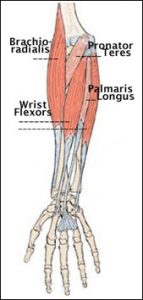When you have pain in your arms and hands, it can be frightening. Knowledge is power. The more you know about your body the less anxious you will be. The more you understand where the pain is coming from, the more confident you will be talking to medical professionals. There are a lot of muscles in the forearm, the section between your elbow and wrist. Here’s how they are organized and what they do.
 The extensor muscles lift the fingers and hand. The flexor muscles make a fist and bend the hand toward the inside of the wrist. There are two layers of flexors and one layer of extensors.
The extensor muscles lift the fingers and hand. The flexor muscles make a fist and bend the hand toward the inside of the wrist. There are two layers of flexors and one layer of extensors.
The extensors (illustration to the left) are located on the back of the arm (dorsum, like the dorsal fin of a fish) and attach to the bone in the elbow farthest away from the body called the lateral epicondyle of the humerus, the upper arm bone. (The finger extensors are to the left in red. The wrist extensors are just on either side of them.)
 The flexor muscles are on the fleshier belly side of the arm and attach to the bony prominence closest to your body (medial epicondyle). The finger flexors are between and under the wrist flexors on two levels.
The flexor muscles are on the fleshier belly side of the arm and attach to the bony prominence closest to your body (medial epicondyle). The finger flexors are between and under the wrist flexors on two levels.
The flexors and extensors are arranged like sandwiches with the muscles that move the wrist on the outside, like the bread, closest to the two bones (radius and ulna) and those that move the fingers down the middle like the sandwich filling.
The two muscles that move the hand palm down (pronator labelled to the right) and palm up (supinator below left in gold) are close to the crook in your arm. Plus there is one small helping pronator quadratus at your wrist between the two arm bones.
 Then there are a four short specialized muscles at the wrist end that move the digits you use the most, one for the index finger and three for the thumb. (See illustration to the left in green, blue and pink.)
Then there are a four short specialized muscles at the wrist end that move the digits you use the most, one for the index finger and three for the thumb. (See illustration to the left in green, blue and pink.)
Three muscles don’t fit into any category. The brachioradialis (above right) starts on the upper arm bone (brachio refers to the upper arm) and ends at your wrist on the bump of bone closest to the thumb (styloid process of the radius). It’s the one you use to twist off the lid of a jar. The palmaris longus (above right-meaning the long one to the palm) attaches to the medial epicondyle with the flexors and is the only muscle whose tendon sits on top of the carpal ligament at the wrist. The other nine tendons go through the carpal tunnel with the median nerve. The palmaris longus makes a claw of the hand (like holding a baseball) and helps to flex the wrist. Last is the little anconeus (left in brown) that works with the triceps to straighten the elbow. (see at left in brown at elbow)